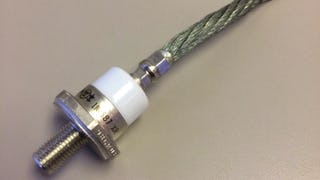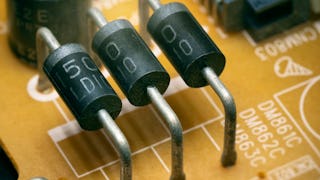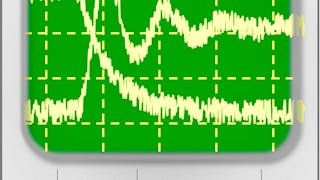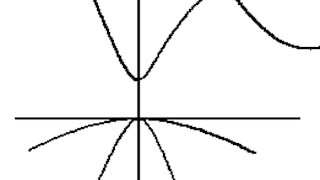This course can also be taken for academic credit as ECEA 5631, part of CU Boulder’s Master of Science in Electrical Engineering degree.



Diode - pn Junction and Metal Semiconductor Contact
This course is part of Semiconductor Devices Specialization

Instructor: Wounjhang Park
13,710 already enrolled
Included with
(293 reviews)
What you'll learn
Analyze pn junction at equilibrium and under bias, capacitance and current characteristics, and breakdown behavior
Analyze metal-semiconductor contact at equilibrium and under bias, capacitance and current characteristics, nonrectifying contact and surface effects
Skills you'll gain
Details to know

Add to your LinkedIn profile
4 assignments
See how employees at top companies are mastering in-demand skills

Build your subject-matter expertise
- Learn new concepts from industry experts
- Gain a foundational understanding of a subject or tool
- Develop job-relevant skills with hands-on projects
- Earn a shareable career certificate

There are 4 modules in this course
In this module, we look at pn junction in equilibrium. Topics include: Device structure for pn junction, Energy band diagram at equilibrium for pn junction, Depletion approximation for step junction, Poisson's equation for step junction, Energy band diagram of pn step junction, Beyond depletion approximation, Poisson's equation, Energy band diagram for linearly graded junction, Energy band diagram for heterojunction, and Effect of band alignment for heterojunction.
What's included
5 videos5 readings1 assignment1 peer review1 discussion prompt
In this module on pn junction under bias, we will cover the following topics: Energy band diagram of pn junction under bias, Capacitance-voltage characteristics, Impact ionization, Avalanche breakdown, Avalanche breakdown voltages, Tunneling current, Zener breakdown, Energy band diagram of pn junction under forward bias, Continuity equation, Boundary conditions, Ideal diode equation, Long- and short-base diodes, Recombination and generation in depletion region, Non-ideal current, Effect of band alignment, and Diffusion and thermionic emission currents.
What's included
7 videos3 readings1 assignment1 discussion prompt
In this module on metal semiconductor contacts, we will cover the following topics: Device structure, Equilibrium energy band diagram, Electrostatic analysis, Energy band diagram under bias, Capacitance-voltage characteristics, Image charge, Dependence of barrier height on electric field, Energy band diagram of Schottky contact under bias, Thermionic emission current, Ohmic contact by heavy doping in semiconductor, Ohmic contact by low metal work function, Surface states, Fermi level pinning.
What's included
6 videos3 readings1 assignment1 peer review1 discussion prompt
In this module on LEDs, we will cover the follow topics: Basic operating principles of LEDs, Survey of LEDs, Blue LED and solid state lighting, Basic principle of semiconductor laser, Condition for net stimulated emission, Types of semiconductor laser, Photodiode, Avalanche photodiode, Solar cell operating principle, and I-V characteristics and power output.
What's included
4 videos3 readings1 assignment1 discussion prompt
Earn a career certificate
Add this credential to your LinkedIn profile, resume, or CV. Share it on social media and in your performance review.
Build toward a degree
This course is part of the following degree program(s) offered by University of Colorado Boulder. If you are admitted and enroll, your completed coursework may count toward your degree learning and your progress can transfer with you.¹
Instructor

Offered by
Explore more from Electrical Engineering

University of Colorado Boulder
 Status: Free Trial
Status: Free TrialArizona State University

University of Colorado Boulder
 Status: Free Trial
Status: Free TrialUniversity of Colorado Boulder
Why people choose Coursera for their career




Learner reviews
293 reviews
- 5 stars
71.67%
- 4 stars
17.06%
- 3 stars
6.14%
- 2 stars
1.70%
- 1 star
3.41%
Showing 3 of 293
Reviewed on Jun 29, 2020
THE CONCEPTS WERE SIMPLE AND NO COMPLEX TERMINOLOGY IS USED, BUT PROBLEMS IN QUIZ FROM SEEK 3 & 4 ,WERE DIFFICULT TO SOLVE JUST FROM LISTENING TO THE LECTURES.
Reviewed on Jun 18, 2020
Good course but not self sufficient. One must read books in parallel to pass the homework problems.
Reviewed on Apr 5, 2022
Coursera helped me learn skills to develop my career and enrich my expertise.

Open new doors with Coursera Plus
Unlimited access to 10,000+ world-class courses, hands-on projects, and job-ready certificate programs - all included in your subscription
Advance your career with an online degree
Earn a degree from world-class universities - 100% online
Join over 3,400 global companies that choose Coursera for Business
Upskill your employees to excel in the digital economy
Frequently asked questions
To access the course materials, assignments and to earn a Certificate, you will need to purchase the Certificate experience when you enroll in a course. You can try a Free Trial instead, or apply for Financial Aid. The course may offer 'Full Course, No Certificate' instead. This option lets you see all course materials, submit required assessments, and get a final grade. This also means that you will not be able to purchase a Certificate experience.
When you enroll in the course, you get access to all of the courses in the Specialization, and you earn a certificate when you complete the work. Your electronic Certificate will be added to your Accomplishments page - from there, you can print your Certificate or add it to your LinkedIn profile.
Yes. In select learning programs, you can apply for financial aid or a scholarship if you can’t afford the enrollment fee. If fin aid or scholarship is available for your learning program selection, you’ll find a link to apply on the description page.
More questions
Financial aid available,

